C5 Interior Sound Reduction
our 2002/carcover/ramps/back to main/C5mods page/ham radio
Summary: The Quiet Kote spray made some improvement; but not a lot. The Frost King material made a day/night difference by almost eliminating road irregularity noises. But tire noise, although reduced somewhat... seems to still be seeping in.
Interior noise was getting the best of me. First there was tire noise (thank-you Goodyear); and the problem of road noise being conducted into the cabin. I especially notice this when driving over a non-perfect road or highway expansion joint. I swear you could hear a noise just running over a paperclip!!!
Then I read about a CorvetteForum members work to reduce noise and cabin heat: http://www.corvetteforum.com/techtips/viewsubtopic.php?SubTopicID=247&TopicID=1
The first area I tackled was the inner fender area. This was to reduce tire noise. I used a spray-on dampening product made by Cascade:

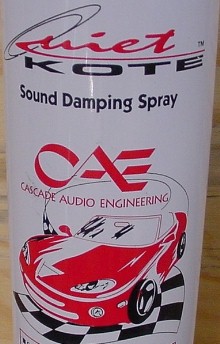
I removed the rear wheels and the wheel wells. Prep all areas to be sprayed with lacquer thinner, and allow it to fully dry, Masking the important areas, I sprayed the inner fender areas (note: the fender well is removed in this pic):
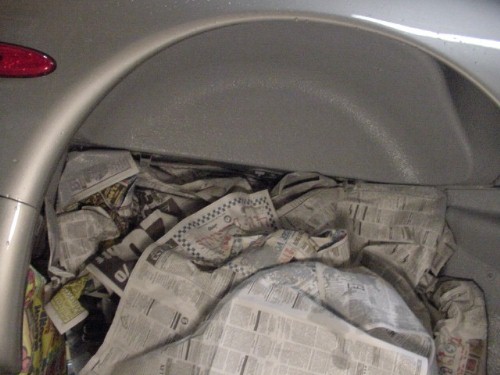
then I sprayed the inner-cavity area (hidden area) of the removed fender wells (notice I did not coat the foam pads... I didn't think I needed to):
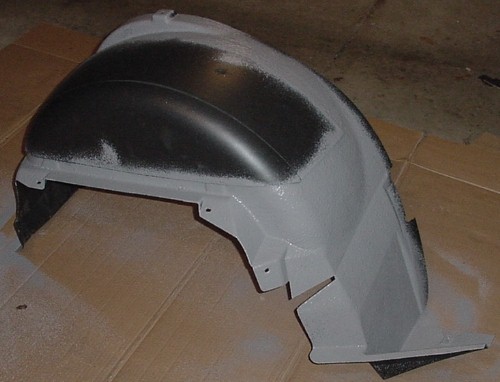
It took two cans of the Cascade for the entire job, which gave it two decent coats. Once all assembled, test drives did denote mionor reduced tire noise, but the road noise wasn't reduced at all. I have learned that tire noise alone can be greatly reduced by filling a tunnel underneath the fenderwell that extends up into the rear of the cabin (near the sides of the seats).. The link to the CorvetteForum Tech Tip (at top of page) gives instructions for that procedure.
Next I attempted to conquer the road noise. The back hatch area of the C5 is a fiberglass/plastic sounding board. I chose this material to not only form a sound barrier, but to dampen the plastic rear tub... stopping it from vibrating and conducting sound. I purchased 3 rolls of this material ($15 per roll) at Lowes in the heating/AC section ( the SKU at Lowe's is 28929 ); 1/8" thick and weighs 3 lbs per roll:
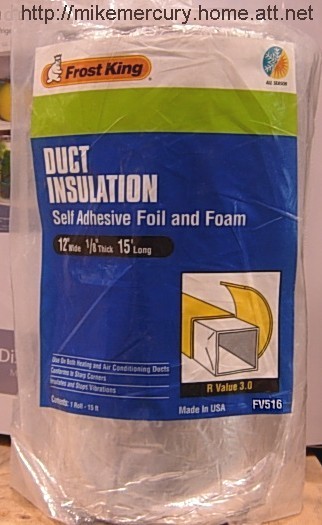
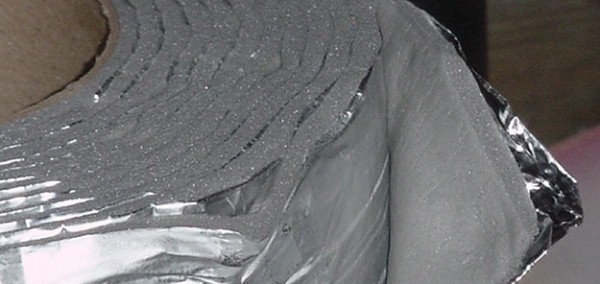
The foam is very dense and adhesive backed (I pealed away some of the foil for the pic above). Called either "Frost King" or "Thermwell". The package graphics may vary, but the Lowes SKU should always be #28929
If you can't find the product locally, you can buy it online here:
http://www.lowes.com/lkn?action=productDetail&productId=28929-1410-FV516
*
It must be quality material because the FAA has approved its useage to "line" the inside of metal skinned private aircraft. From this web site:
ref: http://www2.roversnorth.com/roversnorth/wwwboard/messser/26508.html
I sound proofed my other Aluminum beast about three years ago. (A single engine airplane). The FAA is a bit picky about what you use for such things as aircraft parts. Well I ordered a sound proofing kit ($500.00- you thought Rover stuff was expensive!). The kit contained a very expensive FAA approved piece of paper and seven rolls of "Frost King" brand 1/4 inch foam backed with aluminum foil. This is the same stuff (sans FAA letter required by law) used to deaden sound on ridged A/C duct. Home Depot sells it for $19.00 a roll. On the plane, I first pulled all of the interior trim and insulation out, stuck the frost king stuff to the inside of the aluminum skin and reinstalled the insulation and trim.
It worked well in the plane. I cannot find anyone who has an STC (FAA letter) to allow me to install this stuff in the Rover :).
Now when I tap on the cabin walls of the plane I get a dull thud v. the ringing sound I used to get.
SW
----------------------------------------
I removed all the rear hatch carpeting and padding.This material molds around shapes very well. (In the pics below, I hadn't quite finished applying the material):
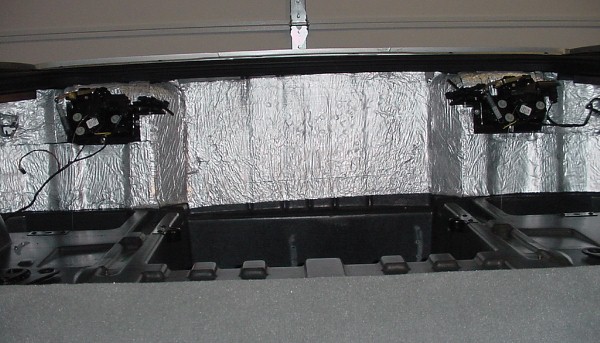
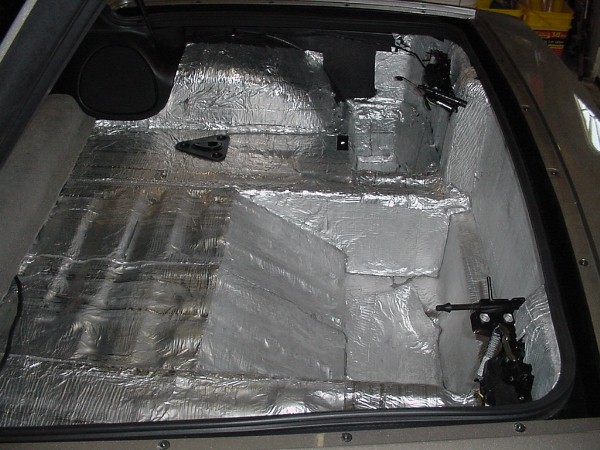
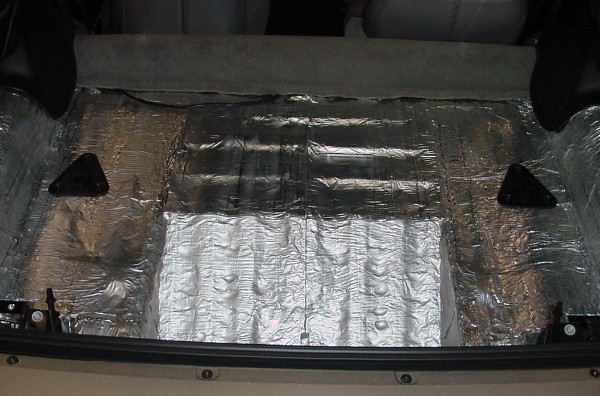
to remove the hatch area carpeting:
Quarter twist the roof panel storage blocks, then lift off:

Next, pry off the outer plastic trim piece (the center most section remains):

unscrew and remove the rear-side plastic wing nuts:

Remove the side carpet pieces first, then the rear vertical piece, next the bottom carpeting, then the padding. I also removed the remaining parts of the roof panel storage blocks; layed down the foam, then relocated the holes with an icepick... re-attaching the pieces over top the foam.
I used the remaining part of the third roll and placed two 12" x 22" pieces on the vertical panels behind the seat backs.
Next I finished the project by removing the seats and lined the lower cockpit areas. This took two more additional rolls of the Frost King insulation (5 rolls for the entire project):
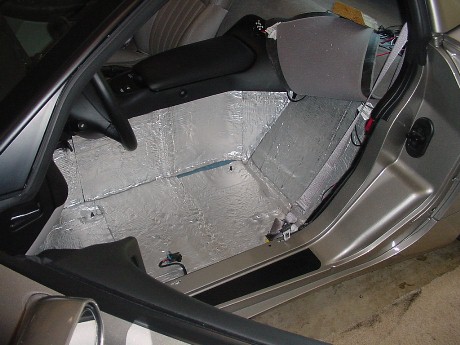
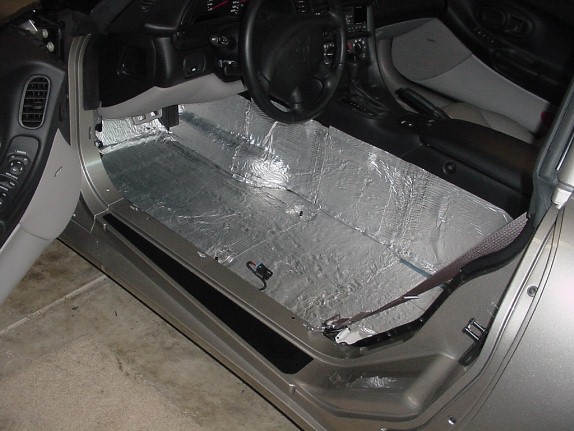
After re-installing the original carpet and padding, a test drive brought big smiles. Tire noise was reduced . Exhaust noise at idle/steady-speed-cruise was mostly nonexistant; and road noise (especially highway expansion joints) was almost completely gone. I just wish I had done the interior first before the wheel wells. The sprayed wells did result in some improvement; but the bulk of the reduction was from insulating the interior.
NOTE: I was somewhat cautious using the foil/foam product on the sides of the tunnel, since many report the tunnel can become very warm... almost hot. Although the Frost King product's intended use is for home-heating/cooling ductwork and (as per mfg specs) can handle temps up to 200 degrees , there is another product that can do better at blocking the heat than the Frost King material. Lowes stores carry another thin insultaing product in their home insulation area of the store. It is foil on both sides with a thin layer of other material sandwiched inbetween (it does not have an adhesive backing). It will perform better as a thermal barrier. You would still use the Frost King foil-foam product in the rear hatch area and cockpit... but for the actual tunnel this other material can be substituted in. The other insulation is sold as "Reflectix Insulation" in the home-insulation isle. You can read about it's useage by clicking here:: CorveteForum Tip by Bill (EvilTwin)
I probably would of used the more expensive, dense, & heavier Dynomat type product if my insulation goal was to reduce vibration caused by a high-powered aftermarket stereo system. But all I was trying to eliminate were driving type sounds... exhaust reverberation, tire noise, and noises caused by rough street surfaces.
contact Tim
